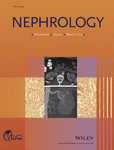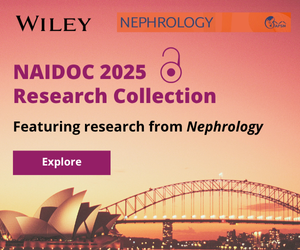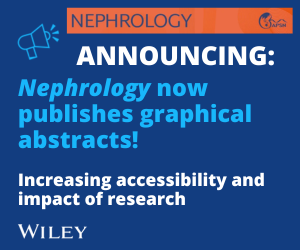Journal list menu
Export Citations
Download PDFs
Issue Information
EDITORIAL
Chronic kidney disease in disadvantaged populations
- Pages: 113-116
- First Published: 24 February 2015
REVIEW ARTICLES
Transcutaneous measurement of glomerular filtration rate in small rodents: Through the skin for the win?
- Pages: 117-123
- First Published: 12 November 2014
This methods in renal research article describes a new non-invasive technique to measure glomerular filtration rate in small animals. Furthermore, this technology has potential for broader use in renal research, such as in measuring the rate of clearance of albumin from the circulation in animals with proteinuria.
Four years of experience with the Australian kidney paired donation programme
- Pages: 124-131
- First Published: 19 November 2014
This Australian report reviewed the 4-year experience of kidney paired donation programme which provides an alternative source of live donor kidney transplantation.
Study of microRNA in diabetic nephropathy: Isolation, quantification and biological function
- Pages: 132-139
- First Published: 09 December 2014
The authors are experts in examining the role of microRNAs in kidney disease. In this invited review, the authors describe the methods they have used to isolate, quantify and analyse microRNAs in the development of diabetic nephropathy.
DIALYSIS
The rationale and design of the Beta-blocker to LOwer CArdiovascular Dialysis Events (BLOCADE) Feasibility Study
- Pages: 140-147
- First Published: 10 November 2014
This study aimed to reduce cardiovascular (CV) events among dialysis patients. This is a trial design paper for the feasibility of a randomized controlled trial to evaluate beta-blockade (carvedilol 3.125 mg bid titrated to 6.25 mg bid or heart rate threshold 55 beats per minute vs placebo) among patients on dialysis. The feasibility will inform recruitment, logistics and intra-dialytic hypotension. Findings will be used to design full-scale study on CV outcomes.
Initiating acute dialysis at earlier Acute Kidney Injury Network stage in critically ill patients without traditional indications does not improve outcome: A prospective cohort study
- Pages: 148-154
- First Published: 13 November 2014
This was a single-centre prospective cohort study of medical and surgical intensive care patients with acute kidney injury studying outcomes following renal replacement therapy.
Acute renal replacement therapy was initiated in 140 patients: traditional indications in 56 (40%); Acute Kidney Injury Network (AKIN) Stage 3 without traditional indications in 38 (27%); and AKIN Stage 1 or 2 with ‘compelling’ conditions in 46 (33%) patients.
Initiating dialysis at earlier AKIN stage did not improve survival in patients without traditional indications.
Patients with diabetes as the primary kidney disease have a worse survival than patients with comorbid diabetes in chronic haemodialysis patients
- Pages: 155-160
- First Published: 09 December 2014
This prospective cohort-study addresses whether the survival of chronic haemodialysis patients with diabetes as a primary disease is different from those who have diabetes as a comorbidity.
Icodextrin decreases technique failure and improves patient survival in peritoneal dialysis patients
- Pages: 161-167
- First Published: 09 December 2014
This study investigated whether icodextrin use can decrease technique failure and prolong patient survival in incident PD patients. The use of icodextrin once daily can decrease technique failure and improve survival in incident PD patients. This suggests that the use of icodetrin will be of benefit for PD patients.
TRANSPLANTATION
Early withdrawal of calcineurin inhibitor from a sirolimus-based immunosuppression stabilizes fibrosis and the transforming growth factor-β signalling pathway in kidney transplant
- Pages: 168-176
- First Published: 18 November 2014
In this prospective randomised controlled trial the withdrawal of calcineurin inhibitor therapy in moderate risk renal allograft recipients was associated with improvement in histological status of the transplant.
A 25-year experience of kidney transplantation in Thailand: Report from the Thai Transplant Registry
- Pages: 177-183
- First Published: 10 December 2014
This report from the Thai transplant registry summarises 25 years of data collected between 1987 and 2012. It is the largest kidney transplant registry in South-East Asia, incorporating data from 26 centres across the country with 3808 recipients included. As well as the dramatic increase in the number of kidney transplants being performed annually, the evolution of practice over this time period is also evident.
CHRONIC RENAL DISEASE
Implementation of renal key performance indicators: Promoting improved clinical practice
- Pages: 184-193
- First Published: 17 November 2014
The authors implemented renal key performance indicators to improve outcomes and established limited gains in two of them, namely, the proportion of home dialysis patients dialysing and timely listing of patients for transplantation.
Urinary Emmprin, matrix metalloproteinase 9 and tissue inhibitor of metalloproteinase 1 as potential biomarkers in children with ureteropelvic junction narrowing on conservative treatment
- Pages: 194-200
- First Published: 03 December 2014
This is a study designed to validate the use of urinary extracellular matrix metalloproteinase inducer (Emmprin), matrix metalloproteinase 9 (MMP-9) and tissue inhibitor of metalloproteinase 1 (TIMP-1) as a marker of ureteric obstruction. The authors found that these three proteins increased in the obstruction group during their follow-up. The authors concluded that urinary MMP and related proteins may be noninvasive potential biomarkers that could be used for long-term follow-up of children with UPJ narrowing on conservative treatment to determine those who might develop obstruction.
Is renal hyperfiltration protective in chronic kidney disease-stage 1 pregnancies? A step forward unravelling the mystery of the effect of stage 1 chronic kidney disease on pregnancy outcomes
- Pages: 201-208
- First Published: 03 December 2014
In a historical prospective study in 383 within 14-gestational week pregnancies with stage 1 CKD, Piccoli et al. showed that pregnancy outcomes was not affected by hyperfiltration. However, stage 1 CKD was associated with prematurity and low birth weight.
Net endogenous acid production and mortality in NHANES III
- Pages: 209-215
- First Published: 13 November 2014
Net endogenous acid production (NEAP), an estimate of net dietary acid intake, is a risk factor for glomerular filtration rate (GFR) decline and might contribute to excess mortality risk in chronic kidney disease. Huston et al. calculated NEAP among 16 906 adult participants in the NHANES III and interestingly found that higher NEAP is not associated with higher mortality in people with low or normal GFR. The underlying mechanism of this observation is still unestablished.
NEPHROLOGY IN HIGH RISK POPULATIONS/INDIGENOUS
Ethnic disparity in prevalence of diabetic kidney disease in an Asian primary healthcare cluster
- Pages: 216-223
- First Published: 11 December 2014
This study aimed to evaluate the prevalence of diabetic kidney disease in a primary care cluster in Singapore and identify its risk factors in a multi-ethnic Asian population. This would be the first out of Asia to describe the epidemiology of diabetic kidney disease in a multi-ethnic population.
CORRESPONDENCES
Segmental Arterial Mediolysis Mimicking Medium-Vessel Vasculitis
- Pages: 224-225
- First Published: 24 February 2015
Autoimmune pancreatitis and minimal change nephrotic syndrome: an unusual association?
- Pages: 225-226
- First Published: 24 February 2015







